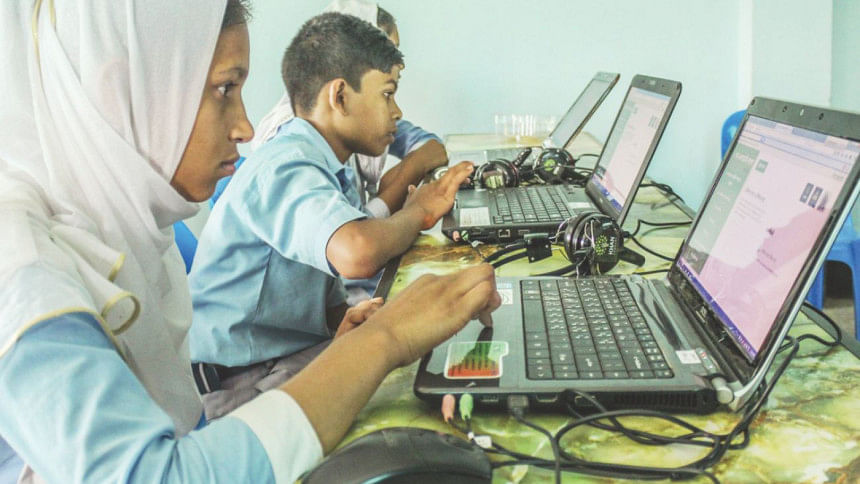When the blackboard comes to life

Looking up information on underprivileged children's education in Bangladesh, I found a picture online of a classroom that looked far from idyllic. The walls and floor were parched, with what was once white paint having been sullied to blotches of grimy yellow and grey. Rickety tables were covered in a copper palette of discoloured wood engraved with meaningless carvings. The corners of a lone white board looked brown and chewed out. Glowing through these depressing shades, however, were splashes of neon green and pink - in a garland of triangular post-it notes hung across the room; on bulletin boards scotch-taped onto the walls; and on numbers forming division and multiplication sums on a projector stationed in the front of the room. Learning from the lesson on the projector were groups of underprivileged young children clad in vivid blue.
The picture was captured at the Aalok Shikkhaloy in Agargaon whose classes have recently been equipped with Khan Academy Bangla's Math tutorial videos with the help of the Agami Education Foundation. Once you realise what is actually happening in this classroom, it becomes an image not of decay or disorder, but of hope and the beginnings of creative thinking.
Khan Academy's YouTube Math tutorials first caught my attention in 2009, when it was slowly gaining popularity among Bangladeshi students preparing for O/A Level examinations. Their easy explanation of complex mathematical concepts became our go-to source of last minute revision, saving many a candidate from panic attacks the night before exams. Established in 2006 by the America-based Bangladeshi educator Salman Khan with the goal of providing "free world-class education for anyone, anywhere," Khan Academy was meant to support students struggling with studies in the capacity of an older brother or sister.

"A big part of that mission is to make sure that people in any region, regardless of what language they speak, have access. Bangladesh is where my family comes from. So it's especially important for me to be able to reach students throughout Bangladesh," explains Salman Khan in a video on the Khan Academy YouTube channel. It was with this vision of reaching beyond English-speaking audiences and connecting with those in dire need of innovative education, that the Agami Education Foundation hopped on board in 2010.
"Both Agami and Khan Academy are based in California, where I happen to live. That's what led to our meeting with Salman Khan in 2010," recalls Dilruba Chowdhury, Vice President of Agami Education Foundation and Director of the Khan Academy Bangla Initiative. "We had already been working in Bangladesh for five to six years. We knew that most students and teachers had been struggling particularly with Math in Bangladesh. And Khan Academy's main focus had been on Math from the beginning. There was, therefore, a lot of synergy when we met; our ideas matched. So we started by translating individual videos to Bangla. In 2011, we translated about 800 videos," she explains.
Over the next few years, Agami started providing these videos to schools through tablets and other devices. Khan Academy also evolved in the meantime, adding exercises for students and evaluation tools for teachers. In 2014, they decided to translate the entire Khan Academy website into Bangla. Joining hands with Grameenphone, who have sponsored the majority of the initiative, and hiring a team of 60 dedicated staff in July of 2015, Agami officially launched the Khan Academy Bangla website in March last year. They have so far translated almost 946 videos from English to Bangla, subtitled 218 others, and are currently helping schools for underprivileged children to incorporate these digital learning tools in traditional classroom settings.
I sat through one of the videos during a visit to Agami's offices in Kalabagan. The website looks neat and colourful, and the Math and Computer Science videos are separated by colour codes. Within each subject, the expansive range of basic mathematical topics come with exercises, generally covering the state curriculum for grades three to eight, although some of the topics may also help explain more advanced concepts for SSC students. By far the most interesting and helpful features of the website are the exercises and the teachers' dashboard.
Suppose a class comprises of 20 students. Each of these students, as well as their teacher, get individual log-in accounts at the Khan Academy Bangla website. The teacher, upon logging in, is presented with a chart summarising which videos have been watched by each student, the marks they received on the exercises they attempted, and even how many minutes of each video was watched by each student. Students' performances are colour coded; the darker the shade of blue, the better the performance of the student. These tools allow the instructor to truly ascertain class performance and pay attention to the specific needs of each student. As per the teaching methods recommended by Agami, the teacher can then either go over the problem areas with the struggling students personally, or assign a peer group system where classmates help each other to learn and revise. This improves not only their academic performance, but also their skills of leadership, teamwork, and initiative.
The learning process itself is meant to be fun and interactive. The video I watched – a tutorial on basic addition – uses colourful shapes and symbols to show how different types of items can be added or subtracted. Glowing baubles of purple and blue appear against a black background meant to keep the visuals simple yet attractive. The tone of instruction is light and informal; it sounds like a storytelling session or even a casual conversation with an older friend. It somehow refrains from sounding preachy or condescending, which is a major deviation from most Bengali instructional videos for children.
"My lessons are much more structured now. It was great to see how excited the children were to engage with the learning platform. Eventually I had to start choosing who would go first, because so many of them volunteered at the same time," shares Maliha Fawzia Farah in a video uploaded on the Agami Foundation project site. Maliha, a 'Teach for Bangladesh' Fellow and a teacher of Mathematics at the Aalok Shikkhaloy school, was one of the first to incorporate Khan Academy Bangla into her classrooms. She started out by playing the videos during class time and choosing different groups of students to use the multimedia tools. "The excited response from these students encouraged us to move forward with the idea of involving other schools," shares B. M. Fazle Rabbi, Project Manager of the Khan Academy Bangla Initiative at Agami Education Foundation.
Challenges sprung up once the initiative took flight. Some teachers, used to traditional teaching methods, were reluctant to adapt this new medium that would demand them to learn as much as the students. The children, some of whom had never even seen a computer before, would stiffen completely while holding the mouse. From helping them embrace these novelties, to recruiting and training translators through rigorous stages of quality control, the Agami team has overcome a host of difficulties to train and equip three more schools with Khan Academy Bangla so far. Among them are Shohag Shopno Dhara and Hazrat Shahali Model High School in Mirpur, and one other school based in Jamalpur. Some of them are equipped with computer labs that allow all students to use individual computers at school, courtesy of the ICT Ministry. Ten more schools are expected to be added this year.
So what about quality checks and maintaining standards? Fazle Rabbi responds, "You will notice that some of the earlier videos may not have clear audio or video quality, or the topics may not be explained very well. We have improved on these things through trial and error. The test site included translation of 2 million words. Another 10 million have been targeted for Computer Science topics. We are slowly working on the Science topics although Math is still very much the main focus. Localising words and contexts is also a major task. We have to convert currencies, numerical units, and adjust examples that may be common to the American culture, such as baseball or basketball, but not so much here. Meanwhile, feedback from teachers has helped us develop or add particular topics that students were finding difficult." They also carried out a small study of sorts – comparing 21 of their students with 21 other randomly selected students, they found out that the children learning with Khan Academy Bangla performed much better than the others.
In two years, Khan Academy Bangla has gone from attracting 100 daily users to above 350 today. Along the way they have attracted teams of dedicated young interns, volunteers, and fulltime staff, who are encouraged to participate at their office as well as in the schools. Volunteers receive Certificates of Appreciation and and Certificates of Participation, respectively, for putting in more than 100 and 1000 hours with the Agami Foundation. Today, their biggest operational challenge lies in attracting funds. They have organised a crowd funding campaign (indiegogo.com/projects/help-agami-localize-khan-academy-in-bangla-education#/) that has attracted a majority of donations from the USA, but not that many from Bangladesh.
A conversation with the Agami team shows how much pleasure they take in their job. It isn't simply about paying lip service to philanthropic initiatives, but truly helping the children that they are able to reach. Asked about what needs most work in the education scene in Bangladesh, especially for disadvantaged children, Dilruba Chowdhury stresses on the need for qualified, motivated teachers who can make education enjoyable. "As far as training is concerned, we are providing it. But retaining them through monetary incentives, and inspiring them to continue in the profession, is where the real challenge lies," she says. This puts the ball back in our court – what are we doing to contribute to this worthwhile cause? How can we help?
The writer is a member of the Editorial team, The Daily Star.

 For all latest news, follow The Daily Star's Google News channel.
For all latest news, follow The Daily Star's Google News channel. 



Comments